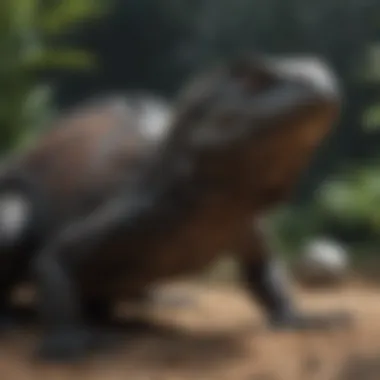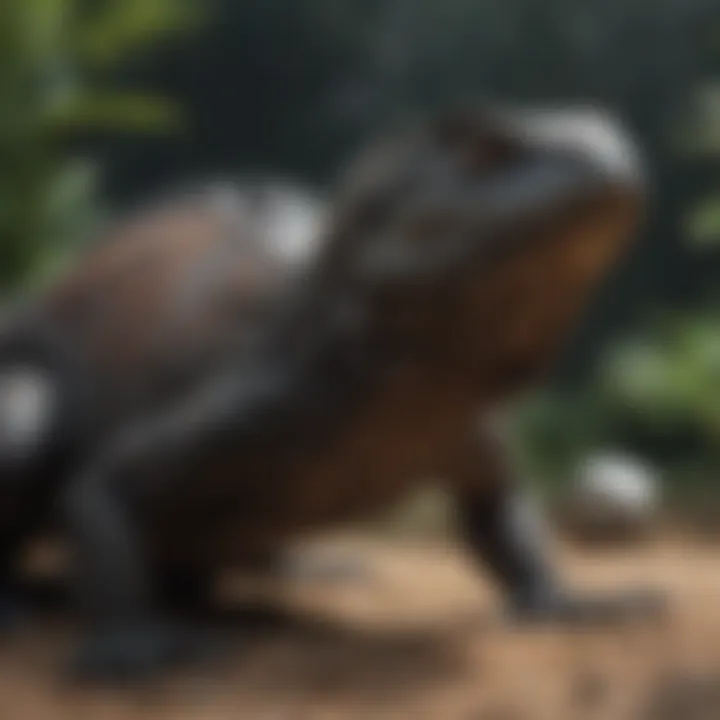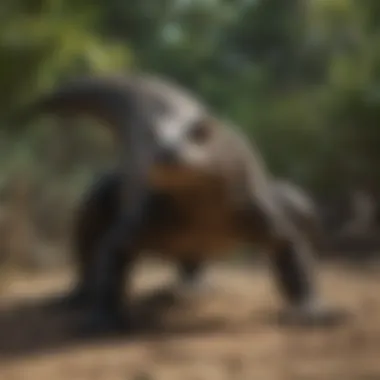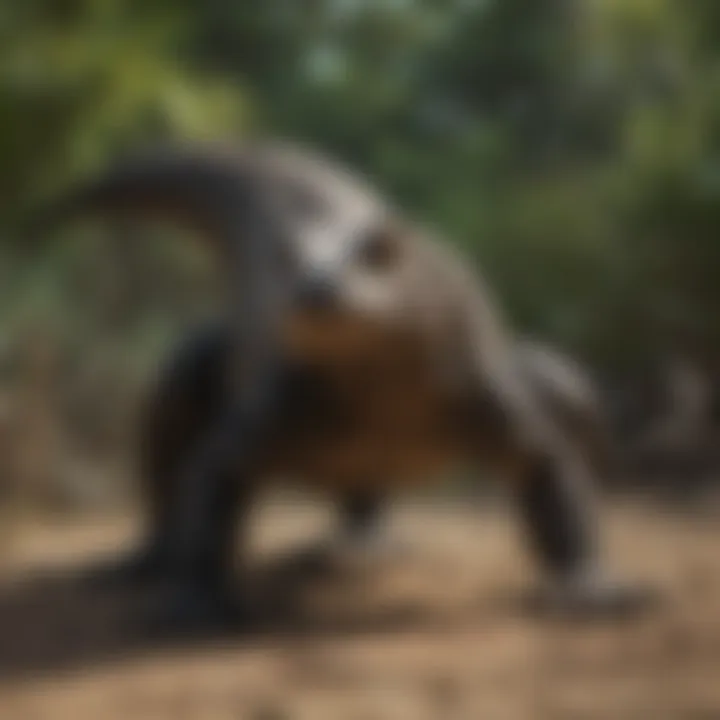The Komodo Monitor: Biology, Behavior, and Conservation


Intro
The Komodo monitor, commonly referred to as the Komodo dragon, is an intricate subject worthy of detailed examination. It stands as a symbol of both ecological wonder and conservation urgency. This article aims to dissect various aspects of this unique species, illuminating its biology, behavior, and the pressing issues surrounding its conservation. Researchers and environmental enthusiasts share a significant interest in this species due to its status as the largest living lizard in the world.
The Komodo monitor resides primarily in Indonesia, specifically on the islands of Komodo, Rinca, Flores, and Gili Motang. Understanding this animal is crucial because it plays a vital role in maintaining the ecological balance of its habitat. The exploration within this article serves to fill gaps in current knowledge about the species, making it a vital resource for students, educators, and professionals focused on biodiversity and conservation.
Throughout this piece, we will delve into various elements of the Komodo monitor’s life, such as its physiological characteristics, dietary habits, reproductive strategies, and the challenges it faces due to environmental changes and human activities. Each section builds upon the last to create a comprehensive portrait of the Komodo monitor, emphasizing its complexities and the importance of preservation efforts.
Intro to Komodo Monitors
The Komodo monitor is a species that garners significant interest from researchers and conservationists due to its unique biology and ecological importance. It is essential to understand the Komodo monitor not just for its size and appearance, but also for its role in local ecosystems and the conservation challenges it faces today. This section will provide an overview of its taxonomical classification and historical significance, thereby laying the groundwork for a comprehensive understanding of this remarkable animal.
Taxonomical Classification
The Komodo monitor, scientifically known as Varanus komodoensis, belongs to the Varanidae family, which includes other monitor lizards. This classification indicates that it shares key traits with its relatives, such as a robust body and a powerful bite. Understanding its classification helps in comprehending its evolutionary background, which is crucial for effective conservation strategies. The taxonomical hierarchy identifies the Komodo dragon within the reptile kingdom, linking it to various environmental adaptations.
Historical Significance
The historical importance of the Komodo monitor extends beyond zoological curiosity. It presents a unique narrative intertwined with human history, culture, and conservation efforts. First documented by Western scientists in the early 20th century, the Komodo dragon has become a symbol of Indonesia's rich biodiversity and extraordinary wildlife. Its interactions with local communities have shaped perceptions, influencing tourism and conservation policies. Understanding these historical contexts is vital for appreciating both the challenges and opportunities for conserving this species.
The Komodo dragon has captured the imagination of many cultures, standing as an iconic representation of natural history.
By studying its taxonomic classification and historical significance, we can begin to appreciate the complex interplay between the Komodo monitor and its environment, setting the stage for a deeper exploration of its biology, behavior, and the various threats to its survival.
Habitat and Distribution
The habitat and distribution of the Komodo monitor are crucial elements in understanding its biology and conservation needs. The geographical range of this species determines its interactions with the ecosystem and the resources available to it. Since the Komodo monitor has specific habitat preferences, knowing where it lives can reveal important aspects of its behavior, diet, and reproductive strategies. The uniqueness of its habitat highlights the intricate relationship between the species and its surroundings, affecting not only its survival but also the biodiversity of the regions it inhabits. Understanding these dynamics is vital for effective conservation efforts and ensuring the long-term viability of the Komodo monitor.
Geographical Range
The Komodo monitor is native to a select number of islands in Indonesia, including Komodo, Rinca, Flores, and Gili Motang. This limited geographic range is a significant factor in its vulnerability. The islands provide a mosaic of habitats, but they are also susceptible to human influence and environmental changes. Studies show that the total number of individuals is quite small, further underscoring the need for geographical studies to monitor their population distribution. The restricted range contributes to its endangered status, making it crucial for researchers to understand the full extent of its habitat.
Preferred Habitats
Komodo monitors favor a variety of habitats that support their biological needs. These habitats include dry savannahs, grassy plains, and some forested areas. Each of these environments offers different resources, such as prey availability and suitable nesting sites. Generally, they are found in areas with plenty of open space where they can hunt effectively and bask in the sun.
In particular, the monitor tends to choose areas near water sources, as hydration plays a key role in its daily activities. Moreover, these habitats often overlap with agricultural land, leading to conflict with human populations and habitat loss. Conservation initiatives must consider these factors in order to create effective management plans.
The importance of habitat preservation is clear; without it, the survival of the Komodo monitor is at risk.
Physical Characteristics
Understanding the physical characteristics of the Komodo monitor is essential. These factors provide insight into the species' capabilities, adaptations, and ecological niches. Not only do physical traits influence survival and reproductive success, but they also play a critical role in interactions with other species. The unique morphology and locomotion of these creatures shape how they navigate their habitat, hunt for food, and engage with each other. The following sections delve into specific aspects of their physical make-up.
Morphology
The morphology of the Komodo monitor is distinct. This species can reach impressive lengths of up to three meters, making it the largest lizard on Earth. The body is robust, with muscular limbs and a strong tail that aids in balance and mobility. The skin is covered with tough, overlapping scales that protect it from environmental hazards and predation.
The head is broad and flattened, featuring powerful jaws equipped with serrated teeth. This anatomy allows the Komodo monitor to effectively take down prey much larger than itself. Notably, the dragons possess a keen sense of smell, aided by their specially adapted forked tongue that samples the air. This keen olfactory ability is critical for locating food and navigating their terrestrial ecosystem.


"The unique adaptations of the Komodo monitor, especially its morphology, highlight its evolutionary success in its environment."
Its coloring varies, usually encompassing earthy tones like browns and greens, aiding in camouflage. This helps them blend into the vegetation of their habitats, enhancing their stalking and ambushing abilities. Overall, the morphology of the Komodo monitor plays a significant role in its survival, making it an excellent predator in its ecosystem.
Locomotion and agility
The agility of the Komodo monitor is remarkable despite its large size. These lizards display a unique combination of strength and speed. They can run quickly over short distances, making sudden ambush attacks on prey possible. Their legs are positioned to support their weight effectively while allowing for thrust during movement.
The Komodo monitor's locomotion is not just limited to rapid movement on land. In water, they are adept swimmers, capable of diving and navigating with ease. Such versatility means they can exploit various habitats for feeding and breeding.
One notable aspect of their agility is observed during defensive behavior. When threatened, they can retreat quickly into dense underbrush or climb trees if necessary, escaping predation or confrontations with larger predators. This ability to adapt locomotion for both hunting and safety illustrates the complexity of their behavior as related to their physical traits.
In summary, the physical characteristics of the Komodo monitor, including its morphology and agility, contribute significantly to its ecological role. These traits define how it interacts with its environment, assembles its predator-prey dynamics, and manifests its survival strategies. An understanding of these characteristics is crucial as we consider their conservation and the challenges the species faces.
Diet and Feeding Behavior
Understanding the diet and feeding behavior of the Komodo monitor is crucial for several reasons. First, it reveals information about the species’ ecological niche and its role within the ecosystem. This part of the investigation highlights the types of prey that the Komodo monitor consumes and how these dietary habits affect its behavior and physiology. Additionally, exploring feeding habits provides insight into the conservation status of the species, since disruptions in their feeding can signal broader ecological issues and threats to their survival.
Dietary Preferences
The Komodo monitor is primarily a carnivore. Its diet mainly consists of large prey, often including deer, wild boar, and smaller rodents. They also consume carrion, which is an important part of their diet when live prey is scarce. Interestingly, their preference for larger animals aligns with their size and strength, allowing them to take down prey much larger than themselves. This behavior showcases their role as apex predators in their habitat.
As scavengers, the Komodo monitors contribute to the ecosystem by cleaning up carcasses, which aids in disease control and nutrient cycling. Research has shown they can consume up to 80% of their body weight in one meal. In regions with human activity, they may also eat livestock, which brings them into conflict with local farmers.
"The Komodo monitor's ability to adapt to various food sources illustrates its resilience, yet it remains vulnerable to changes in its habitat."
Hunting Techniques
Hunting techniques of the Komodo monitor are as fascinating as their diet. They rely primarily on ambush strategies. Their hunting behavior is characterized by patience and stealth. The monitors will often lie in wait, using their camouflaged skin to blend in with the environment until an unsuspecting prey approaches. Once the moment is right, they can burst forth with remarkable speed for a creature of their size.
These lizards utilize their keen sense of smell, aided by their forked tongues, to detect scents from long distances. After locating their prey, they may use their sharp claws and powerful jaws to grip and immobilize it. Interestingly, their saliva contains venom, which helps subdue the prey by inducing shock and paralysis. This hunting method is efficient; it minimizes energy expenditure while maximizing the chance of capturing prey.
In summary, the dietary preferences and hunting techniques of the Komodo monitor play a fundamental role in its survival and ecological impact. Understanding these aspects can inform ongoing conservation efforts and highlight the species' significance in its natural habitat.
Reproductive Biology
Reproductive biology is crucial when assessing the overall health of the Komodo monitor population. Understanding how these reptiles reproduce gives insights into their behavioral tendencies, genetic diversity, and ecological adaptability. Such knowledge is vital for creating effective conservation strategies. As the Komodo monitor faces various threats, be it habitat loss or climate change, comprehending their breeding patterns can illuminate ways to support their continued survival.
Mating Rituals
The mating rituals of the Komodo monitor display complex behaviors that are fascinating to observe. Males engage in displays of dominance to attract females. These displays can include head bobbing, hissing, and even physical confrontations with rival males. Such behavior is not just about strength; it reflects the overall fitness of the male.
During the mating season, which typically occurs between May and August, females become selective. They assess the fitness of potential mates based on their displays. Successful mating can lead to copulation lasting several hours, which increases the chances of successful fertilization.
After mating, the female departs to find a suitable nesting site. She usually selects a secluded area, often in sandy soil where egg deposition can occur safely from predators. This choice is significant, as the location impacts hatchling survival, further underscoring its importance.
Nesting and Hatchling Development
Nesting and hatchling development are critical stages in ensuring the continuation of the Komodo monitor species. After a period of gestation that lasts about 30 days, females can lay approximately 15 to 30 eggs. The nesting sites are often hidden, providing an essential layer of protection for the eggs from predators.
Once the eggs are laid, the female does not remain with them. Instead, she leaves them to incubate naturally. The incubation period typically takes about 7 to 8 months. The temperature during this time plays a key role in determining the sex of the hatchlings. Higher temperatures tend to produce more males, while cooler temperatures yield more females.


Upon hatching, the baby Komodo monitors are fully independent. They are about 16 inches long and possess innate survival skills acquired over time through their evolutionary history. They rapidly seek cover in trees or burrows, avoiding predators. Understanding these factors surrounding nesting and hatchling development is vital for preservation efforts tailored to protect critical habitats and minimize the impacts of climate change.
"The survival of hatchlings is akin to an ongoing gamble against the odds, shaped by both environmental conditions and ecological factors."
Overall, researching and documenting the reproductive biology of the Komodo monitor offers vital insights into their life cycle. This understanding can aid conservationists in implementing measures that ensure the survival of this remarkable species.
Behavioral Patterns
Understanding the behavioral patterns of the Komodo monitor is crucial for several reasons. These behaviors provide insights into their ecological roles, interactions, and reproductive strategies. This section will elaborate on two key elements: social structure and interactions, along with territoriality. Behavioral patterns can reveal how these reptiles adapt to their environments and share resources within their habitats. Furthermore, studying these behaviors aids in developing effective conservation strategies.
Social Structure and Interactions
Komodo monitors exhibit complex social interactions. They are generally solitary creatures, but they do come together during specific events, especially during the mating season or feeding on large carcasses. Their social structure is not rigid; it is influenced by factors such as age, size, and health.
Young Komodo monitors tend to be more social than adults. They often interact with one another, which is important for learning vital survival skills. As they grow older and larger, they become more independent and assert territorial behavior.
Interactions between Komodo monitors can be aggressive. Dominance is frequently established through displays of size and strength. During confrontations, larger individuals may use visual displays or vocalizations to assert their dominance, although physical fights are not always necessary. In many cases, the presence of a larger monitor will deter smaller ones from approaching food resources or mating opportunities.
Social structure plays a crucial role in their survival and reproduction, affecting their feeding habits and territorial disputes.
Territoriality
Territorial behavior in Komodo monitors is a critical aspect of their survival. These reptiles establish and defend their territories to access resources such as food, mates, and shelter. The size of a territory can vary significantly based on available resources and the density of the Komodo population in a given area.
Komodo monitors communicate their territorial claims through various means, including scent marking and body language. Scent glands located near their cloacas release pheromones that signal presence to other monitors. When defending a territory, they may issue threat displays that include hissing or head bobbing, which can deter intruders.
Territorial disputes can lead to aggression, particularly during the mating season when resources become more contested. Larger males tend to have the most expansive territories, which can lead to increased reproductive success.
"Territoriality ensures that Komodo monitors can efficiently utilize the resources within their environment, contributing to their ongoing survival.”
Ecological Role
The ecological role of the Komodo monitor is significant in maintaining the balance within its ecosystem. As apex predators, they play a vital role in regulating the populations of various species in their habitat. This predation not only influences prey populations but also affects plant communities indirectly by controlling the herbivore numbers that feed on them. Understanding these dynamics is crucial in assessing the overall health of the environment they inhabit.
Predator-Prey Dynamics
Komodo monitors are prolific hunters. They use a combination of speed, strength, and cunning to capture prey. Their diet consists mainly of large mammals, such as deer, wild boar, and occasionally smaller animals. The hunting techniques they employ can vary, often relying on ambush strategies or stalking to minimize detection.
These lizards have a keen sense of smell and can detect carrion from great distances. This ability helps them locate food even in the absence of active hunting. Once they find prey, they use their powerful jaws and serrated teeth to tear it apart. This behavior not only provides nourishment for the monitor but also contributes to the ecological balance. By preying on large herbivores, they help control populations that might otherwise grow unchecked, thereby maintaining a healthy environment.
Additionally, when carcasses are left behind, they become a food source for other scavengers. Thus, Komodo monitors indirectly support other species within their ecosystem.
Impact on Biodiversity
The presence of the Komodo monitor has a profound impact on biodiversity within its habitat. As a dominant predator, they help maintain various species' population dynamics, which is essential for a robust ecosystem. Healthy predator-prey relationships foster diverse species interactions that promote ecological resilience. Without the Komodo monitor, herbivore populations could soar, leading to overgrazing and a decline in plant diversity.
Moreover, the Komodo monitor's role extends beyond immediate predation. By influencing the behaviors and distributions of other animals, they contribute to the complex web of life that characterizes their natural habitat. A balanced environment supports a variety of flora and fauna, enhancing overall biodiversity.
Conservation Status
The conservation status of the Komodo monitor is a critical topic addressed in this article. Understanding the current state of this species is essential not only for scientists and conservationists but also for anyone interested in biodiversity. Conservation status reflects how vulnerable or endangered a species is, impacting the ecosystems they inhabit and the biological diversity of the regions they occupy. The preservation of the Komodo monitor is not merely a matter of species survival; it relates to broader environmental themes, such as habitat destruction, climate change, and human interaction.


Threats to Survival
The Komodo monitor faces several substantial threats that contribute to its current conservation status. Key factors affecting this species include:
- Habitat Loss: Deforestation and land conversion for agriculture have significantly reduced the natural habitat necessary for the survival of Komodo monitors. The islands they inhabit are increasingly fragmented, which disrupts their hunting and breeding activities.
- Human Encroachment: With growing populations on islands like Komodo and Rinca, human activities such as tourism, settlement, and infrastructure development have escalated. These activities lead to disturbance and competition for resources.
- Climate Change: Changes in climate affect the ecological balance within their habitat. Rising temperatures may alter the availability of prey, impacting their ability to thrive in the wild.
- Invasive Species: The introduction of foreign species can disrupt the ecosystem. Predators or competitors that are not part of the natural environment threaten the Komodo monitor’s survival indirectly through competition for food or habitat.
Understanding these threats highlights the complex interplay of factors affecting the species. Conservation efforts must consider these elements to create effective strategies to protect the Komodo monitor.
Conservation Efforts
Numerous conservation initiatives aim to safeguard the Komodo monitor. These efforts are essential to ensure the long-term survival of this unique species. Important actions include:
- Protected Areas: The establishment of Komodo National Park is a significant measure taken by the Indonesian government. This area is crucial for the protection of Komodo monitors and their habitats. Regulations within the park limit human activities that could harm the monitors.
- Research and Monitoring: Regular scientific research helps to monitor the populations of Komodo monitors. Tracking their movements and studying their behaviors provide valuable data that informs conservation policies.
- Community Engagement: Involving local communities in conservation efforts is vital. Educating residents about the importance of protecting the Komodo monitor fosters an understanding of their ecological role and encourages sustainable practices.
- Legislative Protection: National and international laws protect the Komodo monitor from poaching and illegal trade. Strict enforcement of these laws is crucial for their conservation.
"Conservation is not just about protecting wildlife; it's about preserving the intricate balance of ecosystems where these species play critical roles."
Efforts to conserve the Komodo monitor also contribute to broader environmental sustainability goals. By protecting this flagship species, we support numerous other flora and fauna that share its habitat. It is clear that by prioritizing concerted conservation actions, we can work towards a future where the Komodo monitor continues to thrive.
Cultural Significance
The Komodo monitor holds a unique place in the cultural landscape of the regions where it is found. This reptile is not only significant ecologically but also culturally relevant, shaping the narratives, traditions, and beliefs of local communities. Understanding the cultural significance helps illustrate the intertwined relationship between humans and natural ecosystems, particularly in regions such as the Indonesian archipelago, where the species is endemic.
Symbolism in Local Cultures
In many island communities, the Komodo monitor is often regarded as a symbol of strength, adaptability, and survival. Local myths and folklore frequently feature this creature, imbuing it with various meanings. It can evoke both reverence and fear. Its formidable nature as a top predator has led to legends that elevate its status in cultural consciousness.
For example, among some indigenous groups, the Komodo monitor represents a connection to ancestry and heritage. Its presence in the environment is seen as a reminder of resilience and the importance of co-existing with nature. The local belief systems have adapted around the creature, influencing rituals and practices that celebrate or respect its existence.
Furthermore, the Komodo monitor has become an icon for conservation efforts. Its status as a vulnerable species fosters community involvement in protecting the environment, leading to initiatives that blend cultural importance with awareness about biodiversity. The balance between respecting local traditions and promoting conservation makes the Komodo monitor a pivotal element in cultural discussions.
Appearance in Media and Literature
The fascination with the Komodo monitor extends beyond local cultures to media and literature. This reptile has often appeared in documentaries, highlighting its ecological role and conservation needs. Programs produced by national geographic and wildlife channels showcase its life cycle, feeding behavior, and environmental significance. This media portrayal enhances public awareness about the species and its habitat, fostering a sense of global responsibility towards its conservation.
In literature, the Komodo monitor is often depicted not just as a creature of the wild but also as an emblem of the untamed nature that exists in remote parts of the world. Authors leverage its image to explore themes of wilderness, the clash between civilization and nature, and the struggles of survival. Books that feature the Komodo monitor often blend facts with creative narratives, engaging readers' curiosity regarding the animal and its habitat.
Closure
The conclusion of this article plays a crucial role in synthesizing the information on the Komodo monitor. Summarizing the key points provides readers with a lucid perspective on the biological characteristics, behavioral patterns, and conservation challenges. This is essential not only for understanding the species itself but also for acknowledging the urgent measures required to protect it.
The Komodo monitor holds a significant place within its ecosystem, acting as both a predator and a keystone species. This position emphasizes the importance of maintaining its habitat, which is increasingly threatened by human activities and climate change.
Effective communication of these issues raises awareness at various levels. Educators can use this knowledge to foster environmental stewardship in students. Researchers can identify gaps in existing studies and focus future explorations on practical solutions. The general public can gain insight into the importance of biodiversity and the role each species plays in their respective ecosystems.
Summary of Key Points
- The Komodo monitor demonstrates unique evolutionary adaptations that allow it to thrive in specific environments.
- Its dietary habits and hunting techniques highlight its role in regulating prey populations.
- Alarmingly, the species faces threats from habitat destruction, climate change, and illegal poaching, impacting its survival.
- Conservation efforts have been initiated to protect the species, requiring collaboration among governments, local communities, and conservationists.
- Understanding the cultural significance of the Komodo monitor raises awareness of its importance beyond ecological terms.
"The Komodo monitor exemplifies the intricate balance of ecosystems, showcasing the need for continual study and proactive conservation efforts."
Future Directions for Research
Future research on the Komodo monitor should focus on several critical areas:
- Genetic Studies: Examination of the genetic diversity within populations may provide insights into their adaptability.
- Impact of Climate Change: Evaluating how climate variations affect habitats and food sources for the Komodo monitor is vital.
- Conservation Strategies: Developing long-term strategies that incorporate community involvement can enhance the effectiveness of current efforts.
- Behavioral Studies: More detailed observations of social structures and territoriality can shed light on their life history and needs.
In summary, the ongoing study and preservation of the Komodo monitor are essential for understanding not only the species itself but the broader ecological dynamics in which it exists.







